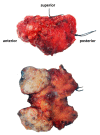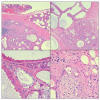PIK3R1, HRAS and AR Gene Alterations Associated with Sclerosing Polycystic Adenoma of the Parotid Gland
- PMID: 36826006
- PMCID: PMC9955459
- DOI: 10.3390/cimb45020061
PIK3R1, HRAS and AR Gene Alterations Associated with Sclerosing Polycystic Adenoma of the Parotid Gland
Abstract
Sclerosing polycystic adenoma (SPA) is a rare neoplasm occurring in the salivary glands, mainly the parotid gland. Although it was originally thought to represent a non-neoplastic process, recent genetic data have proven its monoclonality, supporting its neoplastic origin. We report a case of a 73-year-old woman who presented with left neck swelling and pain. A 3 cm hypoechoic, heterogeneous, solid mass was identified on neck ultrasonography within the left parotid gland. Fine needle aspiration revealed benign acinar cells and lymphocytes. Left partial superficial parotidectomy was performed and a diagnosis of SPA was made. Targeted next-generation sequencing (NGS) revealed three clinically significant alterations in the PIK3R1, HRAS, and AR genes. Alterations in the PIK3R1 gene have been previously reported in cases of SPA; however, this study is the first to report two novel clinically significant genomic alterations in the HRAS and AR genes. AR protein expression by immunohistochemistry was strongly and diffusely positive in the neoplastic epithelial cells compared to the adjacent normal salivary gland tissue, which was dead negative for AR. This molecular profile will enhance our understanding of the molecular pathways underlying the development of this tumor. Although this entity was initially thought to be a reactive process, evidence from our case and similar cases strongly support the notion that it is neoplastic due to the presence of specific genetic alterations linked to it.
Keywords: AR; HRAS; PIK3R1; next generation sequencing; parotid gland; sclerosing polycystic adenoma.
Conflict of interest statement
The authors declare no conflict of interest.
Figures



Similar articles
-
Sclerosing Polycystic "Adenosis" of Salivary Glands: A Neoplasm Characterized by PI3K Pathway Alterations More Correctly Named Sclerosing Polycystic Adenoma.Head Neck Pathol. 2020 Sep;14(3):630-636. doi: 10.1007/s12105-019-01088-0. Epub 2019 Oct 11. Head Neck Pathol. 2020. PMID: 31605313 Free PMC article.
-
Sclerosing Polycystic Adenoma of Salivary Glands: A Novel Neoplasm Characterized by PI3K-AKT Pathway Alterations-New Insights Into a Challenging Entity.Am J Surg Pathol. 2022 Feb 1;46(2):268-280. doi: 10.1097/PAS.0000000000001807. Am J Surg Pathol. 2022. PMID: 34510113
-
Sclerosing Polycystic Adenoma: Conclusive Clinical and Molecular Evidence of Its Neoplastic Nature.Head Neck Pathol. 2022 Jun;16(2):416-426. doi: 10.1007/s12105-021-01374-w. Epub 2021 Aug 19. Head Neck Pathol. 2022. PMID: 34410594 Free PMC article.
-
Sclerosing Polycystic Adenoma.Surg Pathol Clin. 2021 Mar;14(1):17-24. doi: 10.1016/j.path.2020.09.004. Surg Pathol Clin. 2021. PMID: 33526220 Review.
-
Sclerosing polycystic adenosis of the buccal mucosa.Head Neck Pathol. 2008 Mar;2(1):31-5. doi: 10.1007/s12105-008-0042-9. Epub 2008 Feb 26. Head Neck Pathol. 2008. PMID: 20614339 Free PMC article. Review.
Cited by
-
Perineural Invasion in Breast Cancer: A Comprehensive Review.Cancers (Basel). 2025 Jun 6;17(12):1900. doi: 10.3390/cancers17121900. Cancers (Basel). 2025. PMID: 40563551 Free PMC article. Review.
-
Histopathological variations of Sclerosing Polycystic Adenoma: A systematic review.J Taibah Univ Med Sci. 2025 Jun 21;20(3):376-383. doi: 10.1016/j.jtumed.2025.06.005. eCollection 2025 Jun. J Taibah Univ Med Sci. 2025. PMID: 40612964 Free PMC article. Review.
-
Unraveling the Mysteries of Perineural Invasion in Benign and Malignant Conditions.Curr Oncol. 2023 Sep 30;30(10):8948-8972. doi: 10.3390/curroncol30100647. Curr Oncol. 2023. PMID: 37887547 Free PMC article. Review.
References
-
- Gnepp D.R. Salivary gland tumor “wishes” to add to the next WHO Tumor Classification: Sclerosing polycystic adenosis, mammary analogue secretory carcinoma, cribriform adenocarcinoma of the tongue and other sites, and mucinous variant of myoepithelioma. Head Neck Pathol. 2014;8:42–49. doi: 10.1007/s12105-014-0532-x. - DOI - PMC - PubMed
-
- Skálová A., Gnepp D.R., Simpson R.H., Lewis J.E., Janssen D., Sima R., Vanecek T., Di Palma S., Michal M. Clonal nature of sclerosing polycystic adenosis of salivary glands demonstrated by using the polymorphism of the human androgen receptor (HUMARA) locus as a marker. Am. J. Surg. Pathol. 2006;30:939–944. doi: 10.1097/00000478-200608000-00002. - DOI - PubMed
-
- Skálová A., Michal M., Simpson R.H., Stárek I., Prádná J., Pfaltz M. Sclerosing polycystic adenosis of parotid gland with dysplasia and ductal carcinoma in situ. Report of three cases with immunohistochemical and ultrastructural examination. Virchows Arch. 2002;440:29–35. doi: 10.1007/s004280100481. - DOI - PubMed
Publication types
LinkOut - more resources
Full Text Sources
Research Materials
Miscellaneous

